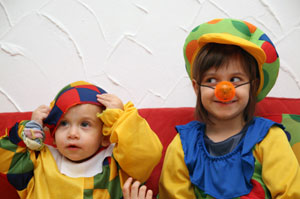I am the tailored type, most comfortable in well-worn denim or comfortable tweeds. My sister, Ellen, has been trying to update my look for years with little success.
A little while ago, when she became engaged, I told her I had nothing to wear to an evening wedding. Today she’s taking me shopping.
At our first stop, she steers me away from a beige silk suit and pulls out several floaty things in colors like plum and teal. “Don’t make a face like that,” she say, pushing me towards the dressing room. “Just try them on.”
I come out in the first outfit, a long chiffon skirt with an asymmetrical hem and a tunic top.
Ellen claps her hands and beams. “It’s wonderful. The color is great on you.” I shake my head.
“It just needs some accessories,” she says, ignoring my doubtful look and heading off towards the jewelry counter.
“Now I know it isn’t your basic black with pearls,” she says, handing me some dangly silver earrings. “But just put these on and twirl around a bit.”
I twirl.
“It’s no good,” I say in despair. ” Every time I put on something like this I feel like I’ve been playing in the dress-up box.”
“Oh Lord,” she laughs, collapsing into a nearby chair. “Remember the glamour?”
How could I possibly forget the treasures contained in the old steamer trunk? Into it, Mother tucked all her cast-off finery: frilly slips and nighties dripping in lace, out-of-fashion high heels, pocket books whose clasps were broken and hats with veils. It became the repository for lengths of fabric, ballet costumes from our past recitals and discarded curtains.
At the bottom of the trunk was a cigar box full of costume jewelry. There were tarnished bangle bracelets which jingled wonderfully when one made imperious gestures (such as “Off with his head!”), fake pearls with peeling luster and single earrings. My grandmother contributed an ornate garnet necklace and pendant earrings. Her marquisette brooch was wonderful for holding capes together. My favorite was the long rope of iridescent Pop-It Pearls and matching earrings the size of silver dollars.
Grandmother’s parasol, its lacy trim somewhat tattered, was prized by whichever of us chose to be the Southern Belle or Mary Poppins or My Fair Lady. (Dad played that record constantly). Grandmother also contributed a evening bag beaded with seed pearls. It was in perfect condition but she said, “I don’t go to balls anymore, dears. You go for me.” And so, in our dress-ups, we did.
Even the most mundane items had their place in the dress-up box. How could you properly play house without aprons and raincoats, bedjackets for sick people and bibs for whoever was being the baby? “Remember the midnight blue satin?” Ellen asks over lunch.
Mother had worn the long satin dress to her engagement party. In the old photographs, she looked elegant in that wonderful dress from the forties with its pleated bodice, long skirt and wide straps. Beside her, Dad stood tall and proud, resplendent in his naval uniform.
Dad contributed plenty of his things to the box too: dented fedoras, ties that had lost their shape, pin striped vests and his old Navy jacket. Occasionally we could coax one of the Miller boys or Connie Borsal’s brother into putting on an old suitcoat and saying in a deep voice, “Honey, I’m home.” But more often than not, I played the father since I was the oldest and, therefore, the tallest.
Aunt Gertrude’s handmade lace tablecloth, no longer fit for the Thanksgiving dinner table, became a bridal veil in countless weddings. It also made an elegant robe when I was a princess in our fifth grade play about the Middle Ages. I made a hat out of a cone of posterboard with a pink chiffon scarf taped to the point. As I gracefully glided onto the stage in the Oak School gym, Mother and my sisters applauded the effect.
With a dress-up box, we could be whatever we imagined. If I felt hurt because I wasn’t invited to Linda Taylor’s birthday party, I could be a princess who would never deign to mix with mere commoners. If Beth had a clumsy day, she could always put on an old ballet costume and glide about like a swan. The day Dickie Colridge told Ellen to “grow up,” she put on the midnight blue satin, slipped her feet into some silver sling-backs that Ginger Rogers might have worn and, taking my suit-coated arm, went to dinner at the Ritz (milk and cookies at the kitchen table served by a haughty waiter — Mother, in an eyeliner mustache).
After a luncheon spent remembering our favorite costumes from the dress-up box, Ellen is eager to continue the search for the perfect dress.
Two hours later, she’s frustrated; I’m depressed.
“One more stop,” she pleads as we approach a tiny boutique owned by a seamstress. Marianna, makes one-of-a kind things, beautifully fashioned of exquisite materials.
In the window is a simple lace sheath. It is cream-colored with long sleeves.
“There,” crows Ellen. “Isn’t that just perfect? Simple lines, elegant fabric.”
I hesitate and grumble, “It looks like Aunt Gertrude’s tablecloth.”
“You’re impossible,” Ellen mutters as she pushes me through the door of the shop.
She’s right. The dress is perfect. I come out of the dressing room and turn slowly. She smiles and sighs, “You look just like a princess.”
I look at myself in the mirror. Maybe not a medieval princess with a pointy hat, but a princess nonetheless. A modern princess who wears blue jeans by day and lace at night.
It has been awhile since I dipped into the magic of the dress-up box and I had forgotten lesson it contained — that through clothing we can be whatever we wish, that make-believe can come true. . . if only for an evening.
